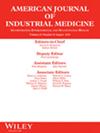Serum Concentration of Selected Per- and Polyfluoroalkyl Substances (PFAS) by Industry and Occupational Groups Among US Adult Workers, NHANES 2005–2014
Abstract
Purpose
Per- and polyfluoroalkyl substances (PFAS) are associated with multiple health effects including pregnancy-induced hypertension and pre-eclampsia, increased serum hepatic enzymes, increased in serum lipids, decreased antibody response to vaccines, and decreased birth weight. Millions of US workers are exposed to PFAS at their workplaces. Our objective was to estimate the serum levels of the five PFAS that are most frequently detected in the US general population(perfluorooctane sulfonic acid (PFOS), perfluorooctanoic acid (PFOA), perfluorohexane sulfonic acid (PFHxS), perfluorodecanoic acid (PFDA), and perfluorononanoic acid (PFNA)) among US adult workers.
Methods
Participants were 4476 workers aged ≥ 20 years with PFAS analyte results available who participated in the National Health and Nutrition Examination Survey (NHANES), 2005–2014. Geometric mean serum levels of PFAS (ng/mL) were obtained across industry and occupation groups using the PFAS subsample weight in SAS-callable SUDAAN V11.
Results
Among 21 industry groups, the highest geometric mean PFAS levels (ng/mL) were observed in Construction (PFOS = 12.61 ng/mL, PFOA = 3.76, PFHxS = 2.10, PFNA = 1.23, and PFDA = 0.33), followed by Utilities (PFOS = 12.46), and Real Estate/Rental/Leasing (PFOS = 12.15). The lowest geometric mean PFAS levels were seen in Private Households (PFOS = 6.34, PFOA = 2.12, PFHxS=0.75, PFNA = 0.86, and PFDA = 0.25). Among 22 occupation groups, the highest geometric mean PFAS levels were observed in Life/Physical/Social Science occupations (PFOS = 13.19, PFOA = 3.54, PFHxS= 1.69, PFNA = 1.23, and PFDA = 0.33), followed by Installation/Maintenance/Repair occupations (PFOS = 12.75), and Construction/Extraction occupations (PFOS = 12.15). The lowest geometric mean PFAS levels were found in Personal Care/Service occupations (PFOS = 7.25, PFOA = 2.43, PFHxS = 1.07, PFNA = 0.94, and PFDA = 0.25).
Conclusions
Some industry and occupation groups had higher geometric mean levels of PFAS in serum compared to others. Further investigation of these industries and occupations may result in a better understanding of the sources and degree of occupational exposure to PFAS.

 求助内容:
求助内容: 应助结果提醒方式:
应助结果提醒方式:


